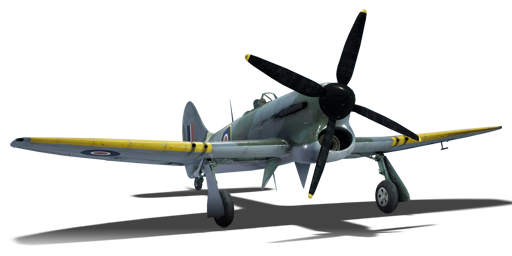

Aviation
Tempest Mk V
IV
Rank
AB
6.0
RB
5.7
SB
6.0
Battle rating
Great Britain
Game nation
Fighter
Main role
46,000

Research
155,000

Purchase
General information
Flight performance
Max speed
at 5,000 m
703634788649 km/h
Rate of Climb
20.41430.114 m/s
Turn time
20.122.418.821.5 s
Max altitude
11,000 m
Takeoff Run
370 m
Landing
flaps
flaps
Take-off
flaps
flaps
Combat
flaps
flaps
Air
brake
brake
General characteristics
Crew
1 person
Engine
Length
10.3 m
Wingspan
12.5 m
Wing Loading
181 kg/m²
Weight:
Base weight
4.644.794.524.76 t
Fuel in main tanks
0.43 t (41m)
Limits:
Max Speed Limit (IAS)
880 km/h
Mach Number Limit
0.87 M
G limit
≈ -7/15 G
Flap Speed Limit (IAS)
L / T / C
269 / 389 / 412 km/h
Gear Speed Limit (IAS)
361 km/h
Offensive armament
4 × 20 mm Hispano Mk.V cannon
Ammunition
800 rounds
Fire rate
750 shots/min
One-second Burst Mass
1.65 kg
| Belt | Belt filling | Armor penetration (mm) at a distance: | |||||
|---|---|---|---|---|---|---|---|
| 10 m | 100 m | 500 m | 1000 m | 1500 m | 2000 m | ||
| HEI/SAP-I/T | 21 | 19 | 14 | 9 | 5 | 4 | |
| AP-T/HEI/SAP-I | 36 | 33 | 24 | 15 | 10 | 7 | |
| SAP-I/HEI/AP-T/HEI/SAP-I | 36 | 33 | 24 | 15 | 10 | 7 | |
| AP-T/HEI/T | 36 | 33 | 24 | 15 | 10 | 7 | |
| AP-T/SAP-I/HEI/AP-T | 36 | 33 | 24 | 15 | 10 | 7 | |
| HEI/SAP-I | 22 | 20 | 14 | 9 | 6 | 4 | |
Suspended armament
Setup 1
2 × G.P. 250 lb Mk.IV bomb
Setup 2
2 × G.P. 500 lb Mk.IV bomb
Setup 3
2 × 500 LB S.A.P. Mk.II bomb
Setup 4
2 × 1000 lb M.C. Mk.I bomb
Setup 5
8 × RP-3 rockets
Economy
Repair cost
Basic → Reference
AB
2,148 → 2,762 

RB
4,880 → 6,276 

SB
7,467 → 9,603 

Crew training
45,000 

Experts
155,000 

Aces
820 

Research Aces
440,000 

Reward multiplier
AB / RB / SB
90 / 190 / 420 % 

160 % 

Total cost of modifications
40,100 

77,200 

Talisman cost
1,400 

Research order:
Flight performance | |
|---|---|
Survivability |
|---|
Weaponry | |
|---|---|
Rating by players
You must play more than 3 battles for the last week and more than 10 battles in a vehicle to rate it.
Like:
30
Flight performance:
Not enough ratings
Survivability:
Not enough ratings
Aerial combat:
Not enough ratings
Ground attack:
Not enough ratings
Balance:
Not enough ratings
Tips & Tricks
This space is currently empty
Do you know any interesting vehicle features?
Loading...
No articles about this vehicle yet
Become the first author and get rewards!
Write a guide, tell about interesting historical facts, make a tutorial or simply an interesting post.
No more content